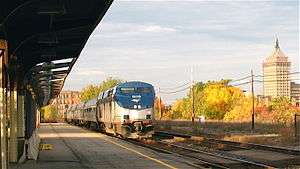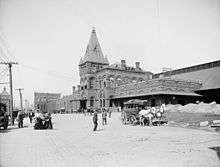Rochester station (New York)
Rochester | ||||||||||||||||||||||||||||||||||||||||||||||||||||||||
|---|---|---|---|---|---|---|---|---|---|---|---|---|---|---|---|---|---|---|---|---|---|---|---|---|---|---|---|---|---|---|---|---|---|---|---|---|---|---|---|---|---|---|---|---|---|---|---|---|---|---|---|---|---|---|---|---|
 An eastbound Empire Service pulling into Rochester | ||||||||||||||||||||||||||||||||||||||||||||||||||||||||
| Location |
320 Central Avenue Rochester, NY 14605 | |||||||||||||||||||||||||||||||||||||||||||||||||||||||
| Coordinates | 43°09′49″N 77°36′30″W / 43.1635°N 77.6082°WCoordinates: 43°09′49″N 77°36′30″W / 43.1635°N 77.6082°W | |||||||||||||||||||||||||||||||||||||||||||||||||||||||
| Owned by | Amtrak | |||||||||||||||||||||||||||||||||||||||||||||||||||||||
| Line(s) | Empire Corridor | |||||||||||||||||||||||||||||||||||||||||||||||||||||||
| Platforms | 1 side platform (formerly also had 3 island platforms) | |||||||||||||||||||||||||||||||||||||||||||||||||||||||
| Tracks | 2 (formerly 8) | |||||||||||||||||||||||||||||||||||||||||||||||||||||||
| Bus operators |
RGRTA routes 37/37x Clinton and 41/41X Joseph Greyhound lines (planned) Trailways (planned) | |||||||||||||||||||||||||||||||||||||||||||||||||||||||
| Construction | ||||||||||||||||||||||||||||||||||||||||||||||||||||||||
| Parking | Yes; free | |||||||||||||||||||||||||||||||||||||||||||||||||||||||
| Disabled access | Yes | |||||||||||||||||||||||||||||||||||||||||||||||||||||||
| Other information | ||||||||||||||||||||||||||||||||||||||||||||||||||||||||
| Station code | ROC | |||||||||||||||||||||||||||||||||||||||||||||||||||||||
| History | ||||||||||||||||||||||||||||||||||||||||||||||||||||||||
| Opened |
Original depot: 1914 Amtrak facility: 1978 | |||||||||||||||||||||||||||||||||||||||||||||||||||||||
| Rebuilt | 2017 (Expected) | |||||||||||||||||||||||||||||||||||||||||||||||||||||||
| Traffic | ||||||||||||||||||||||||||||||||||||||||||||||||||||||||
| Passengers (2015) |
136,861[1] | |||||||||||||||||||||||||||||||||||||||||||||||||||||||
| Services | ||||||||||||||||||||||||||||||||||||||||||||||||||||||||
| ||||||||||||||||||||||||||||||||||||||||||||||||||||||||
Rochester is a station on the Empire Corridor (Empire Service) Amtrak line, located in Rochester, New York.
All trains currently use a temporary platform adjacent to the station building, meaning both eastbound and westbound trains must switch to the southern track. This can cause conflicts with other passenger and freight trains and lead to delays. The current station building in place is a temporary station until the new station is completed in 2017.
The current temporary station does not have high-level platforms, meaning passengers must climb several steps to board trains.
History
Rochester has a long history of train stations. The first major Rochester station was built in 1845 by the New York Central Railroad on Mill Street by High Falls.

In the 1880's the railroad tracks were elevated (having previously been at grade) and the station was relocated to the east side of the Genesee River close to the modern site on Central Avenue at St. Paul Street.

That station would be demolished and replaced in 1914 at the modern site by the more famous New York Central station designed by Claude Fayette Bragdon. At the time the city of Rochester had four major train stations, The New York Central station, the since demolished Erie Railroad Depot, the Lehigh Valley Railroad Station that currently houses Dinosaur Bar-B-Que and the Rochester terminal of the Buffalo, Rochester, and Pittsburgh Railway which currently houses Nick Tahou Hots.[2] The station often referred to as Bragdon Station was four stores with three high arching windows reminiscent of train driving wheels and a main room that was reminiscent of New York’s Grand Central Station complete with arched ceilings and a lunch counter. The station was seen as one of Bragdon's greatest architectural accomplishments. As was the case with several large union stations of the era with falling revenues and high maintenance costs and taxes of such a large facility the station was sold by the New York Central Railroad in 1959 to a private owner.
In a move that is largely considered today to have been a mistake the famed 1914 station was mostly demolished in 1965 after the sale to private owners except for the run down westernmost portion which served as the station in the interim (with the ticket sales at the entrance to the passenger tunnel). That section was demolished to make way for the 1978 Amtrak facility. The 1978 structure was an Amshack style station that was long outdated by the time it was demolished in late 2015 to make way for the current station being constructed.[3]
The passenger, baggage tunnels and platform canopy of the original 1914 building were the last remaining remnants of the previous 1914 station to survive. The tunnels, long forgotten were re-discovered during initial surveying work for the currently under construction station.[4] During construction of the new station the tunnels were filled in as part of the construction of a new tunnel for the station, the westernmost part of the canopy remains.
Future
The construction of a new multimodel transit center is currently underway set to be opened by 2017. The project has been allocated by The City of Rochester, State of New York, and Amtrak US$26.5 million (later US$29.5 million) for construction, and broke ground on October, 28th 2014.[5] [6] The new two floor station is being designed to look like the original 1914 station and will have a high-level center island platform serving two tracks in each direction for Amtrak with two others on either side in each direction for freight traffic pass by. The platform will be connected to the station building via a tunnel underneath the tracks.[6] The station will also contain a retail stand
The new station will also allocate parking for Greyhound and Trailways buses, which currently stop at a temporary facility across the street, and will be built with accommodations for the possible high-speed rail service on the corridor in mind. [5] Rochester's station is being built at the same time as a new station in Niagara Falls.
Service
.jpg)
Amtrak
The following trains stop at Rochester multiple times each day, for a total of eight daily departures:
- Lake Shore Limited: two trains daily between Boston, New York City, and Chicago
- Empire Service (Amtrak): two eastbounds to Pennsylvania Station (New York City) and two westbound to Niagara Falls, NY.
- Maple Leaf (Amtrak/VIA): one eastbound to Pennsylvania Station (New York City) and one westbound to Union Station (Toronto).
Bus Connections
Intercity
The station is across the street from the Greyhound/Trailways station and phase 2 of the new station is to include the buses.
Public Transit
RGRTA service includes
- 37/37x Clinton
- 41/41X Joseph
All buses go to the nearby RTS Transit Center.
Immigration Checkpoint
In 2010 U.S. Border Patrol agents [7] boarded the trains at Rochester station and asked passengers for details of their citizenship. At that time passengers who were not able to suitably prove their right to be in the U.S. could have been removed from the train and taken into custody.
References
- ↑ "Amtrak Fact Sheet, FY2015, State of New York" (PDF). Amtrak. November 2015. Retrieved 9 February 2016.
- ↑ "Monroe County (NY) Library System - Pathfinders - Architecture - Lost Rochester".
- ↑ "Rochester, NY (ROC)".
- ↑ https://www.dot.ny.gov/main/business-center/designbuildproject/repository/NY-Rochester-Station_Report-Evaluation_Tunnels_2012_04_19.pdf
- 1 2 Orr, Steve (October 29, 2014). "Ground broken for Amtrak station". Democrat & Chronicle. Retrieved December 21, 2014.
- 1 2 "Officials will break ground on Rochester train station in August". Democrat and Chronicle. April 3, 2013. Retrieved 2013-04-04. External link in
|publisher=(help) - ↑ "Border Sweeps in North Reach Miles Into U.S.". The New York Times. August 30, 2010.
External links
![]() Media related to Rochester Station at Wikimedia Commons
Media related to Rochester Station at Wikimedia Commons
- Amtrak – Stations – Rochester, NY
- New York Central Railroad Station, Rochester
- Rochester Amtrak Station (USA Rail Guide – Train Web)
- Intermodel Transportation Center DOT Project
- Intermodel Transportation Center DOT preliminary Project
- Rochester, NY (ROC) (Amtrak's Great American Stations)